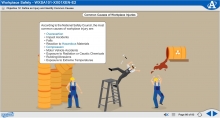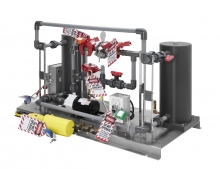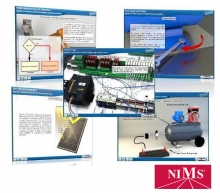V/R Enterprise Safety Training Program
For Any Industry. Save time. Save money. Stay safe. Have fun.
Every individual should be trained with hands-on skills for basic workplace safety. With our Enterprise Safety package, you get seven modules that allow learners to put safety training into practice in a safe, virtual environment. The training modules include:
Workplace Safety
- Confined Space: Students learn procedures for safe entry and monitoring within the confined space; recognize and control hazards that lead to many confined space accidents.
- Fall Protection: Students learn how to select and use proper protective equipment safely in high-stakes fall protection environments.
- Lock Out/Tag Out (LOTO): Students learn how to safely isolate dangerous equipment and energy sources while maintenance and servicing activities are being performed.
- Fire Suppression: students learn general principles of fire extinguisher use and the hazards involved with incipient stage fire suppression using the PASS system.
- AED: students learn how to use an Automated External Defibrillator (AED) to respond during cardiac arrest, extending the opportunity for successful resuscitation.
- CPR: students learn how to administer CPR (Cardiopulmonary Resuscitation) – an emergency lifesaving procedure performed when the heart stops beating.
- Virus Vision: students learn how to prevent the transmission of germs through the workplace through proper infection prevention protocols.
Full Suite of Training Products for Industrial Scenarios
Benefits of Virtual Reality Training
Including VR in your training courses may sound too far-fetched, especially if you’re new to it. The leap from traditional training programs to immersive learning can be a big change for many educators. We are here to help you define your training goals and find the best solutions to achieve them.
- Increases learner engagement
- Increases retention rate
- Helps learners gain proficiency faster
- Improves employee performance
- Reduces costs
- Allows learners to practice in a safe environment
Successful programs should combine classroom and hands-on instructional elements.
Confined Spaces
Few workplace areas present as many life-threatening hazards as a confined space. Without dedicated procedures for safe entry and monitoring employees within the confined space, catastrophic events can occur. Agencies cite a failure to recognize and control the hazards as contributing factors in most confined space accidents.
Training is critical to protecting workers if they enter a confined space.
Students learn and practice hands-on:
- Appropriate communication
- Controlling hazards
- Equipment for safe entry
- Detection of hazardous conditions
- Monitoring
- Supervisor responsibilities
- Attendant responsibilities... and much more!
Fall Protection
Preventing falls can mean the difference between life and death.
When the stakes are high, keep people safe by:
- Training all workers to use the equipment safely
- Providing the right fall protection equipment
- Planning to get the job done safely
Students learn and practice hands-on:
- PPE and proper fall protection equipment
- Harness and Lanyard inspection
- Connectors and Anchor points
- Working at heights
- Lifts and ladders
- Scaffold navigation
- Work environment hazards
Lockout/Tagout
Lockout/Tagout is one of the Top 10 “Most Serious Violations” and Top 10 “Most Often Cited Violations,” according to the Occupational Safety and Health Administration.
The Lockout/Tagout standard requires the adoption and implementation of practices and procedures to shut down equipment, isolate it from its energy source(s) and prevent the release of potentially hazardous energy while maintenance and servicing activities are being performed.
Students learn and practice hands-on:
- Identification and shutting down of equipment
- Notify affected employees
- Proper shut down of equipment
- Disconnect primary energy sources
- Address secondary sources
- Verify lockout
- Service equipment
- Bring equipment back on-line
Option: Fire Suppression
OSHA requires that all employees be trained to use fire extinguishers every year, according to OSHA 29 CFR 1910.157(g). The statute states, “the employer shall provide an educational program to familiarize employees with the general principles of fire extinguisher use and the hazards involved with incipient stage firefighting.”
Students learn and practice hands-on:
- Seeing a fire
- Pulling a fire alarm
- Reaching for a fire extinguisher
- Pulling the pin
- Squeezing the trigger
- Using the PASS system (Pull, Aim, Squeeze, & Sweep)
- Maintain proper distance from the fire
- Know when to move away from a fire
- Check pressure gauges
- Refine their technique and retry if they fail
Fire Suppression
OSHA requires that all employees be educated in the use of fire extinguishers every year, according to OSHA 29 CFR 1910.157(g). The statute states “the employer shall provide an educational program to familiarize employees with the general principles of fire extinguisher use and the hazards involved with incipient stage firefighting.
Students learn and practice hands-on:
- Seeing a fire
- Pulling a fire alarm
- Reaching for a fire extinguisher
- Pulling the pin
- Squeezing the trigger
- Using the PASS system (Pull, Aim, Squeeze, & Sweep)
- Maintain proper distance from the fire
- Know when to move away from a fire
- Check pressure gauges
- Refine their technique and retry if they fail
AED
Learn how to use an Automated External Defibrillator (AED) to respond during cardiac arrest, extending the opportunity for successful resuscitation.
Students learn and practice hands-on:
- Recognize sudden cardiac arrest and call for help
- Work closely with someone performing CPR
- Provide defibrillation with AED until help arrives
CPR
Learn how to administer CPR (Cardiopulmonary Resuscitation) – an emergency lifesaving procedure performed when the heart stops beating.
- Perform initial protocols and check for breathing
- Send someone for help and ask them to call 911
- Perform compressions with proper technique
Virus Vision
Learn how to prevent the transmission of germs in the workplace through proper infection prevention protocols.
- Visualize transmission of germs via air and surfaces
- Recognize potential sources of infection transmission vectors
- Keep productivity losses low by preventing infections







